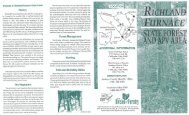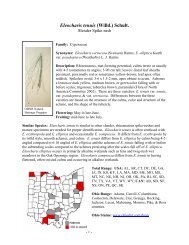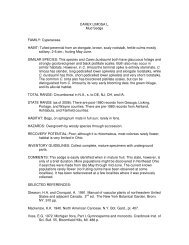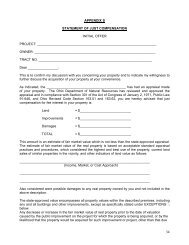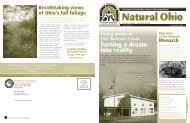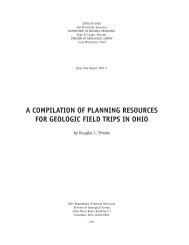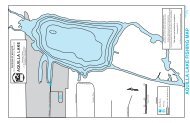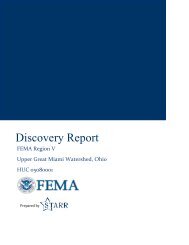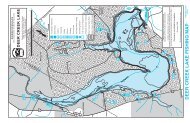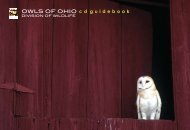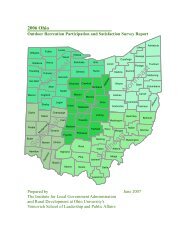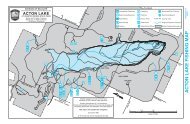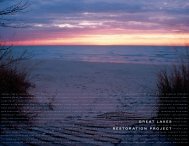Pasture/Hayland Management for Wildlife and Livestock
Pasture/Hayland Management for Wildlife and Livestock
Pasture/Hayland Management for Wildlife and Livestock
You also want an ePaper? Increase the reach of your titles
YUMPU automatically turns print PDFs into web optimized ePapers that Google loves.
<strong>Pasture</strong>/<strong>Hayl<strong>and</strong></strong> <strong>Management</strong><br />
<strong>for</strong> <strong>Wildlife</strong> <strong>and</strong> <strong>Livestock</strong><br />
Habitat change through natural <strong>and</strong>/or human<br />
caused disturbances, such as grazing, has always<br />
been an important management factor in maintaining<br />
quality wildlife habitat. In native grassl<strong>and</strong>s (prairie)<br />
throughout North America, including Ohio, large<br />
herbivores such as bison, elk, <strong>and</strong> white-tailed deer<br />
have grazed the prairie <strong>for</strong> eons, creating a diversity<br />
of habitat that supported a variety of wildlife from<br />
badgers to regal butterflies. In Ohio, grazed grassl<strong>and</strong>s<br />
are especially valuable <strong>for</strong> birds such as the grasshopper<br />
sparrow <strong>and</strong> upl<strong>and</strong> s<strong>and</strong>piper. <strong>Pasture</strong>s also<br />
provide hunting grounds <strong>for</strong> the endangered barn owl<br />
<strong>and</strong> northern harrier. Refer to the Prairie Grassl<strong>and</strong><br />
Habitat <strong>Management</strong> publication <strong>for</strong> more in<strong>for</strong>mation<br />
on grassl<strong>and</strong> birds.<br />
During European settlement times, a few pioneer<br />
farmers recognized the native prairie’s potential <strong>for</strong><br />
pasture <strong>and</strong> hay. One Midwestern farmer wrote “ I can<br />
st<strong>and</strong> on one of these beautiful high mounds <strong>and</strong> see<br />
meadow <strong>and</strong> grass enough to feed all the cattle ... The<br />
prairie grass makes much better pasture <strong>and</strong> hay than<br />
I had any idea of.” Un<strong>for</strong>tunately, most early farmers<br />
were unfamiliar with these native grasses <strong>and</strong> misunderstood<br />
their value as <strong>for</strong>age <strong>for</strong> domestic livestock.<br />
As a result, they converted Ohio’s native prairie to<br />
cropl<strong>and</strong> <strong>and</strong> to non-native cool-season grass/legume<br />
pasture <strong>and</strong> hay. Today, only 1% of the native prairie<br />
remains in Ohio <strong>and</strong> few livestock operators have yet<br />
recognized the benefits of prairie pasture <strong>and</strong> hay <strong>for</strong><br />
livestock production. This publication is designed to<br />
introduce you to a “new” way of managing pasture<br />
<strong>and</strong> hayl<strong>and</strong>. A way that provides both quality <strong>for</strong>age<br />
<strong>for</strong> livestock <strong>and</strong> habitat <strong>for</strong> wildlife.<br />
What <strong>Pasture</strong>/<strong>Hayl<strong>and</strong></strong> management<br />
system is best <strong>for</strong> wildlife<br />
The system that most duplicates “natural” grassl<strong>and</strong><br />
disturbance regimes is best <strong>for</strong> wildlife. <strong>Pasture</strong><br />
<strong>and</strong> hayl<strong>and</strong> management factors such as the timing<br />
of hay harvest <strong>and</strong> pasturing, stocking rates <strong>and</strong><br />
kinds of livestock on the pasture affect wildlife use<br />
<strong>and</strong> abundance. Grazing <strong>and</strong> haying can positively<br />
influence wildlife use if these factors are controlled<br />
Cool-season<br />
Warm-season (Native Prairie)<br />
april may June July august september<br />
Figure 1. Seasonal productivity of cool <strong>and</strong> warm-season grasses.
to modify the habitat structure (i.e., vegetative height<br />
<strong>and</strong> density, plant species composition) in a way that<br />
provides <strong>for</strong> the habitat needs of wildlife. A rotational<br />
grazing/haying management system is currently the<br />
best all around management approach <strong>for</strong> furnishing<br />
quality <strong>for</strong>age <strong>and</strong> providing wildlife habitat.<br />
What is rotational grazing<br />
<strong>and</strong> haying<br />
Rotational grazing is a sustainable farming<br />
practice that involves dividing an area of l<strong>and</strong> into<br />
several paddocks or units <strong>and</strong> moving livestock from<br />
one paddock to another as the season progresses. This<br />
provides adequate recovery time between grazing <strong>and</strong><br />
haying events <strong>for</strong> maintaining grass vigor <strong>and</strong> permits<br />
undisturbed nesting use by wildlife. This also allows<br />
<strong>for</strong> utilizing the <strong>for</strong>age at its most productive period<br />
<strong>and</strong> improves the pasture’s ability to attract wildlife.<br />
The designated management area is divided up between<br />
cool-season grasses <strong>and</strong> warm-season grasses<br />
(native prairie) pasture, hayl<strong>and</strong>, <strong>and</strong> refuge (rest) paddocks.<br />
The management area should be composed of<br />
at least of 30% native prairie grassl<strong>and</strong>. The advantages<br />
of setting up your <strong>for</strong>age management system<br />
this way includes the following benefits: increased<br />
<strong>for</strong>age carrying capacity because cool-season grasses<br />
peak maturity occurs be<strong>for</strong>e June 1 <strong>and</strong> native prairie<br />
grasses peak growth occurs after June 1, hence the title<br />
- warm-season grasses. (Refer to Figure 1).<br />
This extends the length of time the pasture is<br />
providing quality <strong>for</strong>age without the need <strong>for</strong> supplemental<br />
feed, thereby lowering management cost. Native<br />
prairie grasses also have a higher digestibility,<br />
which allows animals to process food faster leading to<br />
faster <strong>for</strong>age intake resulting in faster weight gain per<br />
animal unit. In addition native grasses also produce<br />
high yields <strong>and</strong> high crude protein percentages during<br />
the hot summer months when traditional cool-season<br />
grasses are dormant. Refer to Table 1. The table provides<br />
a comparison of warm-season grasses to a major<br />
cool-season pasture/hayl<strong>and</strong> grass. These advantages<br />
mean that a rotational pasture will create an overall net<br />
income per acre of $100.00 vs. $36.00 <strong>for</strong> a traditional<br />
continuous cool-season pasture.<br />
Table 1. Comparison of warm-season grasses to a<br />
major cool-season pasture/hayl<strong>and</strong> grass.<br />
Species<br />
Average Yield<br />
(Tons per acre)<br />
1 harvest<br />
Percent Crude<br />
Protein<br />
Switch grass 3-4 T/acre 10<br />
Big bluestem 2-2 1 /2 T/acre 15<br />
Indiangrass 2-3 T/acre 10<br />
Eastern<br />
gamagrass<br />
Orchardgrass<br />
w/o alfalfa<br />
3-6 T/acre 12-15<br />
3 T/acre<br />
- 4 harvests<br />
10-18<br />
livestock rotation<br />
livestock rotation<br />
Switchgrass<br />
Paddock size - 20 acres<br />
Grazing - June 1 to July 15<br />
Cool-season grass<br />
Paddock size - 40 acres<br />
Grazing - mid-March to June 1<br />
<strong>and</strong> again from<br />
September 1 to mid-March<br />
<strong>Wildlife</strong> Refuge<br />
Paddock size - 25 acres<br />
All year rest<br />
Big-bluestem/Indiangrass<br />
Paddock size - 30 acres<br />
Grazing - July 15 to September 1<br />
livestock rotation<br />
<strong>Hayl<strong>and</strong></strong> (Eastern gamagrass)<br />
Paddock size - 10 acres<br />
One cut - July 15<br />
Figure 2. Paddocks with grazing <strong>and</strong> haying seasons <strong>and</strong> acres at 1.5 animal units per acre (1 Animal Unit = 1,000 #<br />
live weight) <strong>for</strong> a 20-animal unit/125-acre management area (includes adults <strong>and</strong> young).
How do you set up a rotational<br />
pasture<br />
Divide the management area into at least four<br />
fenced paddocks, including warm-season grass paddocks<br />
planted to switch grass (Blackwell variety),<br />
mixed big bluestem (Roundtree variety)/Indiangrass<br />
(Rumsey variety), Eastern gamagrass <strong>and</strong> a coolseason<br />
grasses paddock planted to a combination of<br />
bluegrass, orchardgrass <strong>and</strong> timothy. Refer to Figure<br />
2 <strong>for</strong> an example.<br />
In<strong>for</strong>mation on planting methods, seeding rates<br />
etc., <strong>for</strong> prairie grasses can be obtained in the Prairie<br />
Grassl<strong>and</strong> Habitat <strong>Management</strong> publication. Cool season<br />
grass establishment in<strong>for</strong>mation can be obtained<br />
by contacting your County Cooperative Agricultural<br />
Extension Agent.<br />
<strong>Management</strong> Guidelines <strong>for</strong><br />
Grazing Paddocks<br />
1. Do not graze newly planted prairie grass st<strong>and</strong>s<br />
until two years after establishment.<br />
2. The optimum time to graze in order to maximize<br />
use of <strong>for</strong>age is when the grasses are in the “boot<br />
stage” of development. The “boot stage” occurs<br />
when the seed heads are within the sheath of the<br />
grass stem.<br />
3. Do not start grazing prairie grasses until they are<br />
at least 12” to 18” high.<br />
4. Remove livestock when grass height reaches 6”<br />
to 8”.<br />
5. Do not graze any of the prairie paddocks later than<br />
September 15.<br />
6. Do not overgraze!<br />
<strong>Management</strong> Guidelines <strong>for</strong><br />
<strong>Hayl<strong>and</strong></strong> Paddock<br />
1. Do not harvest hay on newly planted prairie grass<br />
until two years after establishment.<br />
2. Mixed plantings are the best <strong>for</strong> the prairie hayl<strong>and</strong><br />
paddock such as a combination of Indiangrass<br />
<strong>and</strong> the legume - bush clover. Legumes such<br />
as partridge pea <strong>and</strong> Illinois bundleflower are also<br />
suitable to plant with grasses <strong>for</strong> hay.<br />
3. Big bluestem <strong>and</strong> Indiangrass can be harvested in<br />
late July / August 1. Eastern gamagrass should be<br />
harvested from early July to mid-July.<br />
4. Leave a 50’ wide uncut strip around the perimeter<br />
<strong>for</strong> nesting <strong>and</strong> brooding wildlife.<br />
5. Do not take more than one cutting of hay per<br />
year.<br />
6. Leave a 6” to 8” stubble when cutting <strong>for</strong> hay.<br />
<strong>Management</strong> Guidelines <strong>for</strong><br />
Refuge Paddock<br />
1. Do not hay or pasture refuge paddock annually.<br />
Refuge paddock is to be rested <strong>and</strong> provide undisturbed<br />
habitat <strong>for</strong> wildlife.<br />
2. Plant refuge paddock to a mixture of prairie<br />
grasses <strong>and</strong> flowers. Refer to Prairie Grassl<strong>and</strong><br />
Habitat <strong>Management</strong> publication <strong>for</strong> in<strong>for</strong>mation<br />
on species to include in this planting.<br />
3. Maintain prairie in refuge paddock by harvesting<br />
one cutting of hay every third year.<br />
NOTE: Long-term prairie pasture <strong>and</strong> hayl<strong>and</strong><br />
productivity can be enhanced by periodic fertilization.<br />
Nitrogen can be applied be<strong>for</strong>e grasses reach<br />
4-5 inches in the spring, apply 40-60lbs. of N/acre.<br />
Refer to Prairie Grassl<strong>and</strong> Habitat <strong>Management</strong><br />
publication <strong>for</strong> more in<strong>for</strong>mation on prairie maintenance.



